Lined up at the beach at Fort Desoto, the boats look so promising.
The challengers look anxious but ready and hopeful. Half of them
probably won’t make it to the end in Key Largo but right
now they are all finishers of the Everglades Challenge in their
own minds.
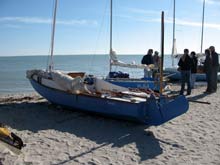 |
Lined up at the beach at Fort Desoto, the boats look so promising.
(click images to enlarge) |
Look at the Challenge results from any year for WaterTribe and
you will see those words after a name... DNF- Did not Finish.
Usually 40 to 50 per cent of those who enter never make it to
the finish. Chief, aka Steve Isaccs of Water Tribe, has said that
looking at the boats on the beach before the start, he can usually
predict which ones will finish and which drop along the way, even
before they launch.
I believe that statement. Why?
It is not the boats necessarily that Chief is talking about,
although sometimes it is--- it is those in them. A great boat
is as likely to be a DNF as a lesser boat. So, what makes a finisher?
It is the body within the boat and the mind within the body. And
perhaps the soul within the mind and body and boat.
It is mostly in the mind, in the resolve, the desire to finish
that this determination is set. It doesn’t matter if we
are talking about finishing a boat, finishing a race or raid,
or just finishing life. Chief talks about filters in the Everglades
Challenge, not just to make the sailing a little harder, but as
a way of limiting who can compete, who can finish. The filters
contribute to that DNF list. This is where so many give up. They
reach a checkpoint and decide “I have gone far enough.”
And they stop.
Think about filters and finishing for a minute here. Where the
going gets hard and harder. Mike made the comment to me this week,
“Anyone can sail around the coast of Florida, it is the
checkpoints that make the Everglades Challenge a challenge.”
Last night I asked Mike about this subject. How did he keep
going? He said, “You just get back in the boat and push
off.” That seems to be the problem, so many can’t
or won’t get back in the boat. Mike admitted it would have
been easy to stop and quit at any checkpoint. But he didn’t,
he got back in the boat.
Right now Mike Monies, my husband, is out in the Boat Palace
building two Welsford Scamps
from scratch. Not from kits but drafting, cutting patterns, cutting
each piece by hand. He has exactly 90 days from today to have
two finished boats on their way to Florida to the Everglades Challenge.
Because plans were not yet complete or available, we started with
prototype plans, which slows down the process slightly as well.
| Mike Monies, my husband, is out in the Boat Palace
building two Welsford Scamps from scratch. |
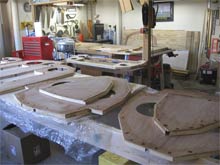 |
Can he make it? Chuck Leinweber of Duckworks, one of his sponsors
thinks he can. John Welsford the designer of Scamp thinks he can.
Small Craft Advisor Magazine, his other sponsor must think or
at least hope so! So do I.
Why do we think that? Because Mike is a finisher. He will not
accept a DNF. The boats will get done and to Florida, because
he just keeps going, like that Energizer bunny. He just gets back
in the boat.
How does Mike build so fast? A question I am often asked to
explain. He has no secret and no magic tricks, he isn’t
even a fast builder. His work is well finished and professional
in its neatness and sturdiness, always built without taking short
cuts. His finishing and painting are almost perfection, with great
attention to detail and small things, things that other people
may never even notice.
His secret is simple and open: he just keeps going. He will
work on that boat every single day, ten hours per day minimum,
whether he starts at 10 a.m. or 8 a.m. Consistency and “stick
to it “ attitude. He knows how long the boats should take,
how many hours. Just work the hours and the boat will be finished.
This sounds so simple, yet I know builders who have started
boats and then stopped the build permanently. They give up, never
go back, sell or throw the hull away, give it away. I also know
those who stay with building for years and years, stop and start,
never finishing the hull.
While Mike was employed and traveling all the time, he still
finished a 23 foot sharpie in six months, his big schooner in
five years of part time work, still traveling constantly in his
job.
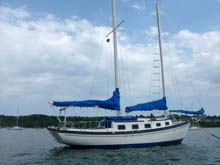 |
Mike finished his big schooner in
five years of part time work, still traveling constantly in his
job. |
When I asked Mike about this, his answer was to be consistent,
even if you can only manage a few hours per week, do it every
week or so many days per week or whatever you can manage. But
do it! Make a date with your boat building project, put it on
your calendar, schedule it in. A boat requiring six hundred hours
of build time like some could be built in 5 hours per night for
two nights and one weekend day of 8 hours.
This minimal amount of time for three days is only 18 hours
total. But in a mere 33 weeks you would have a finished boat,
Eight months! Have I lost anyone here with my math?
Consistency of labor in a time constraint you can handle and
still maintain employment and a family life.
Last year when Mike built Laguna
Dos for the Everglades Challenge, he was forced to practice not
only the consistency but the determination to solve problems,
the stick to it part of a finisher. It froze, it snowed, it iced,
nothing would dry, the epoxy wouldn’t pop, no amount of
heaters would warm the Boat Palace.
But Mike persevered, he didn’t give up, he didn’t
quit. He is not a DNF, but a finisher.
I have often read Chief of the WaterTribe say that getting to
the beach is the hardest part. I know he is right about that one.
Many times last year I did not think Mike or the Laguna would
make it to the beach. Nothing went his way. And that too is a
filter, to solve the problems, to get the boat built, to outfit
the boat and yourself properly, to pass the inspections. For some
this is too overwhelming to do and that filters them out. Only
the truly determined will be at the beach.
Mike pushed on and pressed on, despite all the obstacles the
weather threw at him. He finished the boat, taking her to Florida
at the last possible minute. They were still attaching things
on the beach at Fort Desoto, including her name decals. It had
been too cold in Florida to even do that!
Too cold in Florida, too windy, too stormy to practice with
Andrew Linn, his partner, just flown down from Oregon. Colder
in Florida than in Oregon. They bundled up like Artic explorers
while they finished loading the Laguna and getting gear together
for inspection. But they got to inspection, got the OK for equipment,
got the boat to the beach. One step closer to being a finisher!
At the beach. The hardest step.
Mike and Andrew pushed off in the Laguna Dos, never having sailed
together before. An act of faith on each man’s part, Andrew
in Mike and the boat, Mike in Andrew and his strengths, Andrew
in Mike and his sailing skills, Mike in Andrew and his ability
to learn FAST. Andrew is a fast learner, Mike has him hands down
on sailing experience and years but Andrew knows when to listen.
| Mike and Andrew pushed off in the Laguna Dos, never having sailed
together before. |
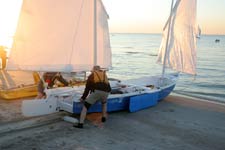 |
They needed this joint respect very quickly. The first leg from
Fort Desoto to Checkpoint 1 turned into a major wind event, with
high rough seas that quickly formed. Mike accessed the situation
rapidly,. Turning into the Venice canal possibly saved them from
capsize, as the Sea Pearl 21, a WaterTribe veteran went over rapidly,
followed by a newer contender in a Wayfarer 16. Both the Wayfarer
crew and the Sea Pearl’s captain were rescued, leaving their
boats to drift hull down before being salvaged.
And here is the first truly acceptable reason to DNF, one that
veterans and new challengers must face- the boat/kayak/canoe is
lost. Lost beyond righting, lost beyond repair, lost beyond going
on. This happens.
If you cannot self-rescue, get the boat up again, bail out the
water and go on, then this is when you say “I have gone
far enough.” Sometimes this happens on day 1, sometimes
further down the course.
When we were studying accounts of prior Everglades Challenges,
trying to learn what to expect, trying to avoid being a DNF, I
read everything I could about equipment failure but especially
equipment failure on Class 4 monohulls. Why did people drop out?
Why did they not finish? And we tried to compensate.
Sails torn on railroad pilings going into a checkpoint? Take
three sails in polytarp and borrow a second new Dacron set in
case of total loss or failure of polytarp. Boat dismasted and
mast broke off? Take two masts and a third mast step to offer
an infinite number of reefing possibilities, design all masts
to be shortened and still sail with reefed sails. Over powered
by too much sail, have enough and then some of reef points to
shorten sail to almost a handkerchief.
Know what was vulnerable to damage on the Laguna, then take
along what it took to jury rig a repair.
Boat capsized and not rightable? Put a line of floatation, inflatable
rollers on port side, to give one side asymmetrical flotation
higher to prevent turtling.
The list goes on and on. We studied what went wrong in past years
and tried to anticipate the boat, the equipment lists. What might
make Mike and Andrew DNF in the boat itself? There were backups
to everything. Andrew was notorious for dropping electronics,
to the point where a friend suggested we duct tape the radio and
GPS to Andrew’s hands. So, we had backups, equipment by
twos, radios, GPS, cell phones, SPOTS. One went down, there was
another, with batteries and chargers on the boat to keep things
charged and working.
It is hard to have a recharger for the human body, however.
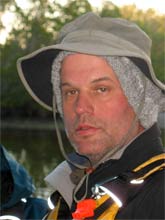 |
It is hard to have a recharger for the human body. |
Bodies break down, mental strengths break down, it is just hard
to keep going. Challengers push their bodies to the point of collapse
and often beyond. This is often the reason they reach the point
where they say “I have gone far enough.” This is where
the toughness, the ability to push off, to keep going comes into
play. Those who go alone have only themselves to call on for strength,
those in teams or a paired crew can support each other.
I asked Mike if there was really a point where he thought they
might not make it, where it looked totally impossible. He talked
of the night they turned into the Marco River, ended up in canals
behind condominiums, no wind, more or less lost, Andrew rowing,
rowing while asleep apparently. Mike began to hallucinate, seeing
forests of trees in the water below them. Andrew was also hallucinating,
believing all the bridges were solid walls of brick and concrete,
with no openings to pass through.
Rowing and making a few miles in hours and hours and hours. I
watched them on satellite that night, watched their SPOT track
barely moving slowly through the canals. At one point they seemed
to have tied up to a dock and stopped. I could see the cars in
the driveways, even trash cans out at the curb. Eerie sight, like
a spy movie or television show.
The canal was narrow, there were houses and driveways, docks
all around them. They were not in physical danger if they had
decided to stop. But they could not stop. They had to keep going.
The ease of stopping, the mind playing games, this is one of greatest
dangers leading to DNF.
Mike also talked of sailing all night, in black darkness, no
moon, no stars, no lights from shore. Just the sound of the boat
slamming into waves, wave after wave after wave. Not even a shadowy
tree line, no shorelines, nothing to steer by, no reference points.
He said he began to question if he had put enough screws into
the bottom when he built the Laguna Dos. Was her bottom going
to fall off and they would sink in the black night? Would they
run into an unseen stump or navigation hazard in the pitch blackness?
Physical injury, real physical injury can cause a drop out and
it probably should. Many who enter these events are not physically
fit enough to complete them. Some are. Some aren’t. No one
should push themselves to the point of broken bones, hypothermia
or complete exhaustion. When that point is reached, it should
be recognized and the boat needs to stop. You need to be able
to determine this yourself or listen to others at this point -
you have gone far enough. Exhaustion causes the mind to play funny
tricks, voices from the clouds, choirs that sing, visions and
confusing apparitions.
Time to stop.
The last major reason for DNF in a sailing event is often the
most insidious. Time.
Making it to each checkpoint sometimes looks easy when you are
sitting home, viewing the distances theoretically. It is a far
different thing when you are actually there, out in the water,
beating into a head wind or paddling against an incoming tide.
Mike told me a story the other night about he and Andrew trying
to sail into a headwind on the last day and last leg of the EC.
They couldn’t make any way, just being defeated for every
inch. They ended up sitting on a mud flat out in Florida Bay,
eating a snack and trying to decide what to do.
Pelican/Dr. Nick Hall, who has finished ten Challenges, passed
them in his Hobie Adventure Island. And he got blown back past
them. He passed them again and again and again. Four times he
got blown back and four times he passed them.
They decided to give up the course they had set to cross Florida
Bay and instead set out the long way across the outside route,
tacking and beating into the wind for 15 hours and 72 miles to
make a distance of 28 miles to the finish in Key Largo.
They finished last in Class 4 Monohulls, the last sailboat to
reach the finish line, with 36 hours to spare.
| Andrew and Mike finished last in Class 4 Monohulls, the last sailboat to
reach the finish line, with 36 hours to spare. |
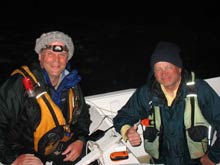 |
They got their sharks teeth, the t-shirt and the paddle. But
more than that, they got to finish.
One of the older and wiser WaterTribe members commented this
week that if a new challenger was studying prior Challenges he
should not look at those that finished a route in two days that
could take eight days but look at those that finished last. Those
finishing last had struggled more, worked harder and faced more
difficulties in order to reach the end. Those were the ones to
study, to say: what did he do, how was he strong enough, where
did the mental fortitude come from?
The finisher comes from within, within the body, within the
mind, within the soul. They just keep going and get back in the
boat.
*** |

